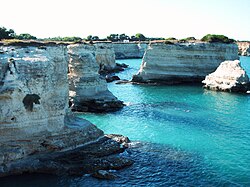
Back Kainosoïkum Afrikaans Känozoikum ALS حقبة الحياة الحديثة Arabic Cenozoicu AST Sidgelkeugal AVK Kaynozoy Azerbaijani Кайнозой Bashkir Кайназой Byelorussian Кайназой BE-X-OLD Неозой Bulgarian
| Cenozoic | ||||||
|---|---|---|---|---|---|---|
 | ||||||
| Chronology | ||||||
| ||||||
| Etymology | ||||||
| Name formality | Formal | |||||
| Nickname(s) | Age of Mammals | |||||
| Usage information | ||||||
| Celestial body | Earth | |||||
| Regional usage | Global (ICS) | |||||
| Time scale(s) used | ICS Time Scale | |||||
| Definition | ||||||
| Chronological unit | Era | |||||
| Stratigraphic unit | Erathem | |||||
| Time span formality | Formal | |||||
| Lower boundary definition | Iridium enriched layer associated with a major meteorite impact and subsequent K-Pg extinction event. | |||||
| Lower boundary GSSP | El Kef Section, El Kef, Tunisia 36°09′13″N 8°38′55″E / 36.1537°N 8.6486°E | |||||
| Lower GSSP ratified | 1991 | |||||
| Upper boundary definition | N/A | |||||
| Upper boundary GSSP | N/A | |||||
| Upper GSSP ratified | N/A | |||||
The Cenozoic (/ˌsiːnəˈzoʊ.ɪk, ˌsɛn-/ SEE-nə-ZOH-ik, SEN-ə-;[1][2] lit. 'new life') is Earth's current geological era, representing the last 66 million years of Earth's history. It is characterized by the dominance of mammals, birds, conifers, and angiosperms (flowering plants). It is the latest of three geological eras of the Phanerozoic Eon, preceded by the Mesozoic and Paleozoic. The Cenozoic started with the Cretaceous–Paleogene extinction event, when many species, including the non-avian dinosaurs, became extinct in an event attributed by most experts to the impact of a large asteroid or other celestial body, the Chicxulub impactor.
The Cenozoic is also known as the Age of Mammals because the terrestrial animals that dominated both hemispheres were mammals – the eutherians (placentals) in the northern hemisphere and the metatherians (marsupials, now mainly restricted to Australia and to some extent South America) in the southern hemisphere. The extinction of many groups allowed mammals and birds to greatly diversify so that large mammals and birds dominated life on Earth. The continents also moved into their current positions during this era.
The climate during the early Cenozoic was warmer than today, particularly during the Paleocene–Eocene Thermal Maximum. However, the Eocene to Oligocene transition and the Quaternary glaciation dried and cooled Earth.
- ^ "Cenozoic". Lexico UK English Dictionary. Oxford University Press. Archived from the original on 23 November 2021.
- ^ "Cenozoic". Merriam-Webster.com Dictionary. Merriam-Webster.